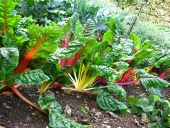
 4
4




Visit Redhawk's soil series: https://permies.com/wiki/redhawk-soil
How permies.com works: https://permies.com/wiki/34193/permies-works-links-threads
 4
4




"Them that don't know him don't like him and them that do sometimes don't know how to take him, he ain't wrong he's just different and his pride won't let him do the things to make you think he's right" - Ed Bruce (via Waylon and WIllie)
 6
6




 5
5




I don't think I've ever seen an ugly cloud, and I don't think I ever will.




I don't think I've ever seen an ugly cloud, and I don't think I ever will.
 7
7




I'd say my first goal is to try growing them under some of my fruit trees to improve the "poly" in "polyculture".Eric Silveira wrote:Jay, are you looking to harvest the roots or the leaves? Or both?
Not *just* ornamental. I need to look up who pollinates them unless you happen to know? My Island is generally characterized as a Domestic Bee desert. But fruit trees grow well, and there are wild pollinators out there, and I'd like to support them. So I guess you could say that if the local pollinators are the ones who "harvest" from them, I'm good with that!That being said, if you are willing to consider ornamental value first and any harvest as a secondary benefit then I would go for it!
Visit Redhawk's soil series: https://permies.com/wiki/redhawk-soil
How permies.com works: https://permies.com/wiki/34193/permies-works-links-threads
 4
4




I don't think I've ever seen an ugly cloud, and I don't think I ever will.

 2
2





 10
10




How Permies works: https://permies.com/wiki/34193/permies-works-links-threads
My projects on Skye: The tree field, Growing and landracing, perennial polycultures, "Don't dream it - be it! "
 4
4




Permaculture...picking the lock back to Eden since 1978.
Pics of my Forest Garden












 6
6




How Permies works: https://permies.com/wiki/34193/permies-works-links-threads
My projects on Skye: The tree field, Growing and landracing, perennial polycultures, "Don't dream it - be it! "
 5
5





Permaculture...picking the lock back to Eden since 1978.
Pics of my Forest Garden

 3
3
















 4
4




How Permies works: https://permies.com/wiki/34193/permies-works-links-threads
My projects on Skye: The tree field, Growing and landracing, perennial polycultures, "Don't dream it - be it! "
 5
5




Visit Redhawk's soil series: https://permies.com/wiki/redhawk-soil
How permies.com works: https://permies.com/wiki/34193/permies-works-links-threads
 4
4




I don't think I've ever seen an ugly cloud, and I don't think I ever will.

 5
5




 4
4




Ahhh... it's just in how people are thinking sometimes. Yes, if I let my Muscovy cross with my Khakis, the eggs are viable, but the offspring are sterile. You get a single generation of hybrid vigor, but that's it.Eino Kenttä wrote:Yes, genetic diversity is the stuff. I meant hybrid in the sense hybrid of two species, though, as in it might be seed-sterile. Guess my wording was a bit weird...
Visit Redhawk's soil series: https://permies.com/wiki/redhawk-soil
How permies.com works: https://permies.com/wiki/34193/permies-works-links-threads












 9
9




When growing well each bulb will divide producing two flowering sized bulbs every year - in addition to that they may also produce a number of smaller offsets.
How Permies works: https://permies.com/wiki/34193/permies-works-links-threads
My projects on Skye: The tree field, Growing and landracing, perennial polycultures, "Don't dream it - be it! "












 4
4




How Permies works: https://permies.com/wiki/34193/permies-works-links-threads
My projects on Skye: The tree field, Growing and landracing, perennial polycultures, "Don't dream it - be it! "

|
I think they should change the spelling to Sandy Eggo. This tiny ad agrees with me.
Freaky Cheap Heat - 2 hour movie - HD streaming
https://permies.com/wiki/238453/Freaky-Cheap-Heat-hour-movie
|







